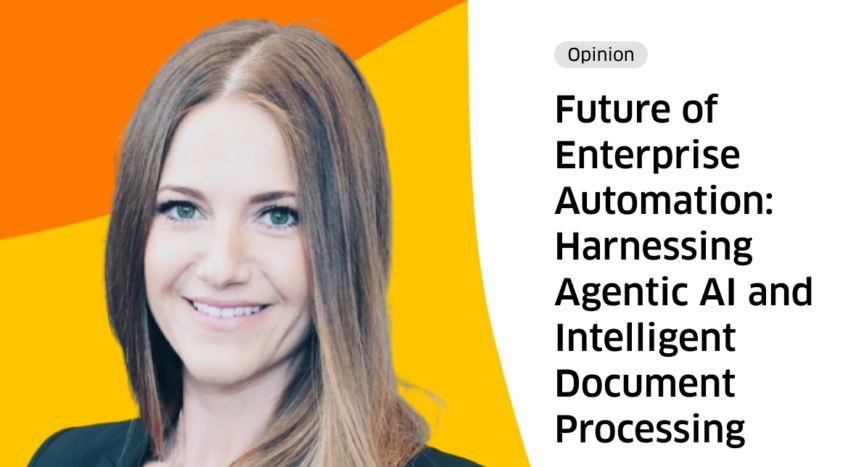Curious about what keeps experts, CEOs and other decision-makers in the Intelligent Document Processing (IDP) space on their toes? Get food for thought on IDP-related topics from the industry’s leading minds.
In this opinion piece, Dr. Marlene Wolfgruber, Product Marketing Lead for AI at Intelligent Document Processing (IDP) vendor ABBYY, explains how technologies such as agentic AI and IDP are redefining automation and how they enable companies to streamline operations, improve decision-making and increase productivity.
In today’s fast-evolving digital landscape, enterprise automation is essential for maintaining competitiveness and operational efficiency. The convergence of agentic AI with intelligent document processing (IDP) presents exciting new opportunities for businesses, driving the next wave of transformation. This post takes a look at how these technologies are redefining automation, enabling companies to streamline operations, enhance decision-making, and boost productivity.
The Shift Toward Agentic AI
While robotic process automation (RPA) has been useful for automating repetitive, rule-based tasks, it faces significant limitations in today’s complex business environment. Agentic AI addresses these limitations by offering a more intelligent and adaptable approach to automation:
- High setup costs vs. more efficient setup: Both RPA and agentic AI require investment in setup and tools, but with the right solutions, agentic AI can offer more streamlined deployment by leveraging pre-trained models and AI platforms, leading to faster results.
- Rigid workflows vs. dynamic adaptability: RPA excels in automating structured tasks but can struggle to adapt to evolving processes. Agentic AI, with its ability to understand and adapt in real-time, brings more flexibility and can adjust dynamically to changes in workflows.
- Limited scope vs. enhanced data processing: While RPA can handle structured data efficiently, it struggles with unstructured data and lacks capabilities like natural language understanding. Agentic AI excels in processing unstructured data when integrated with natural language processing (NLP) and large language models (LLMs), improving comprehension and decision-making.
- Maintenance burden vs. reduced human intervention: Both approaches need ongoing updates as business processes evolve, but the learning capabilities of agentic AI reduce the frequency of manual reprogramming to enable more self-sufficient systems.
- Scalability issues vs. adaptive scalability: Scaling RPA requires careful management of multiple bots, whereas agentic AI can scale more seamlessly across various industries through integration with robust platforms, enhancing workflows without the same level of manual orchestration.
By addressing some of RPA’s limitations, agentic AI unlocks new opportunities for businesses, offering smarter, more adaptive automation when paired with the right tools and implementation strategies. However, both RPA and agentic AI require the right tools and frameworks to operate effectively.
Overview of Intelligent Document Processing (IDP)
IDP uses AI and machine learning to read, extract, and organize data from documents. It processes structured, semi-structured, and unstructured data, transforming content into business-ready information. IDP has evolved from basic optical character recognition (OCR) to sophisticated solutions with capabilities such as NLP, enabling accurate data extraction and comprehension.
Benefits of IDP:
- Operational efficiency: Automates data entry and reduces manual errors.
- Enhanced compliance: Maintains digital audit trails for regulatory adherence.
- Improved customer experience: Streamlines document-centric interactions.
- Scalability: Adapts to process varying document types and volumes.
The Intersection of Agentic AI, APA, and IDP
We know that IDP utilizes AI and machine learning to efficiently read, extract, process, and organize a variety of data from documents, transforming them into business-ready information with enhanced capabilities like NLP. With benefits like improved operational efficiency, enhanced compliance, improved customer experience, and scalability, IDP effectively automates data entry while reducing manual errors, maintains digital audit trails, streamlines document-centric interactions, and adapts to process varying document types and volumes.
The integration of IDP with agentic AI and agentic process automation (APA) represents a groundbreaking advancement in enterprise automation, offering a comprehensive strategy to streamline and optimize business processes across various functions.
Enhancing Enterprise Efficiency
- Seamless data integration: IDP plays a crucial role in APA by providing structured data that drives AI-driven workflows, which enhances decision-making capabilities. By converting unstructured data into actionable insights, businesses can achieve a higher level of operational efficiency and accuracy.
- Automated document handling: AI agents empowered by IDP can automate document-related tasks, such as verifying information, extracting relevant data, and executing transactions. This automation significantly reduces manual effort and minimizes errors, leading to faster processing times and improved productivity.
- Contextual intelligence: AI-powered systems, enabled by APA and enhanced by IDP, have the ability to understand and react to real-world data dynamically. This contextual intelligence allows businesses to adapt quickly to changing environments, improving the accuracy and responsiveness of their operations.
The Role of APA and IDP in Transformational Change
Integrating APA with IDP facilitates transformational change by enabling organizations to move beyond traditional automation. This combination allows for more adaptive and intelligent automation solutions that can continuously learn and improve over time.
Realizing Business Potential
By leveraging the combined capabilities of agentic AI, APA, and IDP, businesses can unlock new levels of efficiency, agility, and innovation. These technologies not only streamline existing processes but also open up new avenues for growth and competitive advantage, positioning enterprises for success in the rapidly evolving digital landscape.
Use Case Examples:
- Financial services: AI agents analyze market data in real-time, executing trades based on IDP-extracted insights.
- Human resources: Automates onboarding processes by extracting data from employee documents and updating systems.
- Supply chain management: AI optimizes logistics by analyzing inventory data and predicting demand fluctuations.
Future Outlook and Recommendations
The integration of agentic AI, APA, and IDP is poised to redefine enterprise automation, offering unparalleled efficiency, insight, and adaptability. To capitalize on these advancements, enterprise decision-makers should:
- Evaluate current processes: Identify areas where AI and IDP can drive improvements.
- Invest in training: Equip teams with the skills needed to harness these technologies.
- Foster collaboration: Encourage cross-functional collaboration to maximize the impact of automation.
- Focus on scalability: Choose solutions that can grow with your enterprise’s needs.
By adopting these technologies, businesses can gain a competitive edge and unlock new levels of performance in the digital age.
Conclusion
Agentic AI and intelligent document processing represent the future of enterprise automation, providing the tools needed to thrive in a rapidly changing environment. By leveraging these technologies, organizations can streamline operations, enhance decision-making, and achieve unprecedented levels of efficiency.
Ready to transform your enterprise with agentic AI and IDP? Learn more about how these technologies can benefit your business and join the forefront of the automation revolution.

About the Author
Dr. Marlene Wolfgruber is the Product Marketing Lead for AI at ABBYY, bringing over 10 years of leadership experience in product management and marketing. She has deep knowledge in a wide range of topics within the intelligent automation industry, and regularly shares her expertise as an expert in AI and language technologies. In her previous roles, Wolfgruber led efforts to revolutionize AI-powered spend management and empowered businesses to build autonomous assistants with generative AI. Wolfgruber holds a Ph.D. in computational linguistics from Ludwig Maximilian University of Munich, and enjoys reading, exercising, cooking, and spending time with her two children.
You may also like:
The Ethical AI Dilemma: Navigating the Future of AI Privacy and Compliance

📨Get IDP industry news, distilled into 5 minutes or less, once a week. Delivered straight to your inbox ↓







